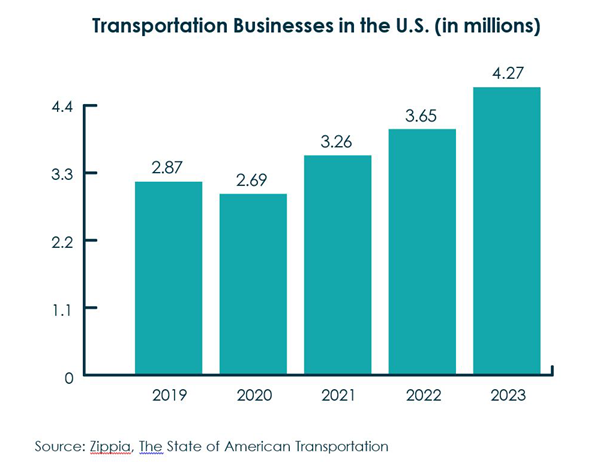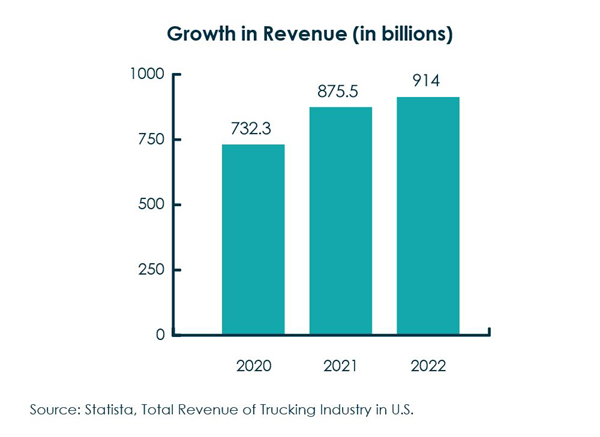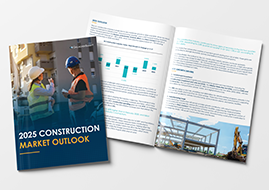By: Doug Betkowski Lori Ilgenfritz

Introduction
March 06, 2024 — The transportation industry plays an essential role in the US economy and its infrastructure. With the demand for transported goods and materials only increasing, trucking organizations are consistently tasked with making deliveries nationwide on tighter deadlines and against a growing number of competitors, which puts a strain on organizations focused on operating safely and responsibly.
However, the COVID-19 pandemic significantly impacted the transportation and logistics sector, and its effects still reverberate today. The increased pressure on daily operations requires more commercial vehicles and drivers — despite shortages in both — and, while many fleets have reallocated vehicles, maintaining daily operations remains challenging. Rising costs threaten companies' bottom lines, and the ever-increasing adoption of technology opens organizations up to a host of unknown risk factors during this time of innovation in the industry.


The opportunities for growth paired with the industry's evolving concerns create an unprecedented landscape that trucking organizations have to navigate. Planning for the future can seem like a balancing act. But, one way for organizations to prepare is to fully understand the industry's current and future challenges and, more specifically, how these challenges will impact their businesses.
In this market outlook, we will explore the current state of the transportation industry, identify some emerging opportunities and challenges, and provide insights into proven risk mitigation strategies.
Current and future industry challenges
Managing growing fleet management costs
Reducing fleet management costs is crucial for trucking organizations going forward. With rising fuel and equipment costs, employee salaries, and claims and litigation costs, organizations need to ensure that each aspect of their business is functioning as efficiently as possible. As suppliers and banks grow more risk-averse, running fleets cost-effectively means prioritizing safety measures to minimize accidents and decrease risk exposure.

Safety awareness, training, and reinforcement are vital at every level of an organization. Best-in-class trucking operations continuously focus on overall safety, specifically while operating trucks on the road. Road conditions, weather, driver shortages, and just-in-time delivery requirements all impact the business, but safely operating the vehicle should be a trucking organization's prime directive.
Insurance and claims can be among the top costs for a trucking company. The best way to reduce these costs is to have fewer or, ideally, no claims, which stems directly from safety on the road. Recent innovations and investments in the operation procedures, such as electronic logs, drive cams, and collision avoidance technology, have created awareness of driver behavior and management. Additionally, cloud-based systems provide real-time operational insights, thereby streamlining fleet management and saving time and money. These improvements enable fleets to be run more efficiently and proactively, ensuring a more cost-effective approach to fleet management.
Rise in litigation against transportation companies
In recent years, the transportation industry has become a target defendant for the plaintiff's bar, which has stemmed from a growing trend of rising verdict damages and a number of six- and seven-figure settlements, thus raising the alarm from a risk and claims management standpoint. In addition, the transportation industry has been facing increased scrutiny, which results in targeted litigation due to the high requirement of insurance limits and the lack of adequate tort reform.
Immediately following an incident, organizations are responsible for mobilizing internal and external stakeholders to relay information to key decision-makers as it becomes available in real time. Getting boots on the ground as quickly as possible will help maintain the integrity of the evidence and the investigation as well as the confidentiality of information to protect business reputation.
Every investigation requires the appropriate experts in place to preserve evidence and protect information. Investing in the right multidisciplinary team, which would include experienced claims professionals, lawyers who understand the context of similar claims, independent adjusters, and public relations representatives, can prove the difference between resolution and a drawn-out, far more expensive settlement. But the best defense against litigation is the prompt and accurate handling of claims by experienced industry professionals.
US driver shortage and lack of skilled drivers
The American Trucking Association recently predicted that the truck driver shortage could potentially reach 160,000 drivers by 2030. The industry also needs to recruit nearly 1 million new drivers over the next decade to compensate for an aging and retiring workforce, combat voluntary and involuntary quitting, and support industry development.
The average age of truck drivers is 46, with much of the driver population set to retire soon and not enough young certified drivers to replace this group. Attracting young and/or highly trained personnel is an ongoing challenge for several industries, including transportation, but a lack of skilled drivers threatens the nationwide economy's infrastructure and organization, as well as the ability of industries to grow. Inexperienced drivers on the road have the potential to increase the opportunity for catastrophic claims and generally the exposure for organizations to more frequent, severe claims.
The current administration has proposed a plan to alleviate the shortage, which includes reducing the time it takes to obtain a commercial driver's license and providing incentives for companies to create apprenticeship programs. Younger, less experienced drivers on the road can increase the risk organizations face in terms of claims frequency and severity. Any changes that require new drivers to complete less training and fewer hours behind the wheel are likely to create even more complex risk management challenges for organizations focused on minimizing risk by operating trucks safely on all roadways. Long-term solutions will likely need to address increased pay, regulatory changes, and modifications to the business practices of shippers, receivers, and carriers. These solutions mean investing in programs that attract younger people to the profession and providing them with a path to a career.
Automation also has the potential to revolutionize the industry. Previously, around 80% of warehouse activities were done by hand, but as demand increases, organizations may need to automate more actions or augment manual labor with technology to work more efficiently and effectively. The transportation industry will need to adapt to implement this sort of technology for drivers to use so that the future state of trucking can be realized. Organizations need to invest in technology and tools that empower drivers while also providing training and education programs that will attract the workforce of the next generation to careers in the transportation industry.
Regardless of the strategy, trucking companies are responsible for providing their employees with proper training and making sure safety protocols are in place. They need to use the available technology and data to continuously evaluate and develop these practices so that drivers, warehouse workers, and the public are protected.
Evolving digital requirements
Artificial intelligence is driving the evolution of claims and risk management in the transportation industry. Increasingly, risk managers have to be proactive and fully invest themselves in understanding how the metrics produced from the technologies in the truck are predictive and can help analyze and prevent accidents. For example, if a risk manager sees that a driver continually speeds, frequently brakes hard, and erratically changes lanes, the manager can proactively intervene before a serious accident occurs.
With immediate access to this critical claims and risk information, organizations can prepare for adverse events ahead of time and, better yet, prevent them from happening in the first place. Technology is creating safer, faster, and smarter transportation practices and empowering businesses to evolve quickly.
However, many transportation organizations are still figuring out how to handle information technology systems and the insights they provide. For starters, the cost of implementing modern technology as well as the logistics of implementing it during everyday operations presents a challenge for companies of all sizes. Organizations then also need to be equipped to handle the influx of electronic data (for both storage and claims purposes), potential technological problems or defects, and the implementation of cybersecurity. Vulnerabilities in technology and data security pose a significant threat to any industry, but for transportation, as a critical piece of the supply chain, a cyber-based vulnerability could be devastating for operations and the economy at large. The "usual" security concerns — sensitive data, such as inventory and customer information, employee records, banking information — make trucking companies a target, and with the rapidly changing tech landscape within the transportation industry, protecting this information becomes even more critical.
In the coming years, organizations must balance the push for the adoption of technology, with its unique — and perhaps new — challenges, and how it slots into their growth goals. Trucking companies should continuously review their operations and make any necessary changes as their needs and the needs of their customers change.
Conclusion
The transportation industry is poised for significant change in the coming years as new technologies and dynamic regulatory landscapes continue to reshape day-to-day business operations. Trucking organizations should prioritize risk mitigation strategies and preventive safety measures to help control costs and reduce the risk of incidents on the road. If challenges within the industry necessitate reducing the time it takes to obtain a license in order to attract new talent and meet driver demand, trucking organizations should review and perhaps re-prioritize their training methodologies to mitigate future exposure. In the face of so many challenges, choosing the right claims and risk management partner is essential to continuing the positive growth and success of organizations in the future.
To learn more about Gallagher Bassett's partnered approach for the transportation industry, visit our transportation industry solutions page.
Sources
Flynn, Jack. "The State of American Transportation," Zippia, 16 Feb 2023.
"Total Revenue of the Trucking Industry in the United States from 2014 to 2021," Statista, accessed Dec 2023.
"Transportation Services in North America," MarketLine, Sept 2017.
"Employment, Hours, and Earnings from the Current Employment Statistics Survey for Transportation and Warehousing," U.S. Bureau of Labor Statistics, accessed Dec 2023.
Costello, Bob and Alan Karickhoff. "Truck Driver Shortage Analysis," American Transportation Associations, Jul 2019. PDF file.
"Global Transport Market Report (2020 to 2030) — COVID-19 Impact and Recovery," Globe Newswire, 3 Sep 2020. Press release.
Zaturanov, Sergey. "A Forecast of the Trucking Crisis as We Head Into 2022," Forbes, 30 Mar 2022.
"5 Trends of Digital Transformation in Transportation and Logistics," Yoh, 21 Sep 2023.
Authors

Doug Betkowski

Lori Ilgenfritz
Make Gallagher Bassett your dependable partner
When making the right decision at the right time is critical to minimize risk for your business, count on Gallagher Bassett's extensive experience and global network to deliver.

